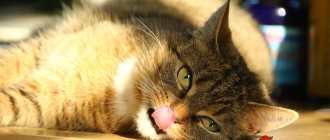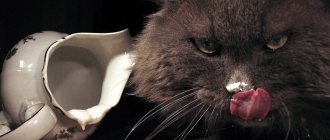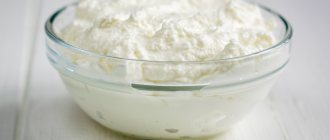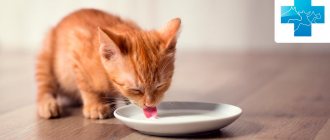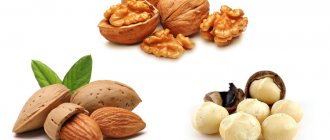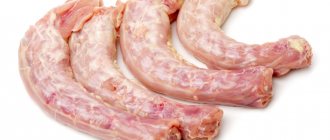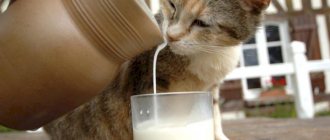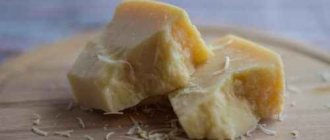The benefits of milk for the body are invaluable, because it is not in vain that it is the first product that mammals become familiar with. Cats are no exception, and the love of pets for this nutritious product is mentioned in many literary works and magazines. However, in practice everything is different. Caring owners will definitely think about whether it is possible to give a cat milk at all, because often after the appearance of milk in the diet the animal begins to feel unwell.
Relationship between cat age and milk consumption
Cats belong to the class of mammals, and therefore it is natural that milk is a necessary food for them, but this only applies to kittens. Until the age of 6-8 weeks, their main diet is mother's milk. Babies' bodies completely digest the food they eat, but as animals grow older, they may experience symptoms of lactose intolerance.
An unpleasant condition for an animal can be recognized by a number of signs:
- bloating;
- diarrhea;
- vomit;
- the appearance of skin irritation, itching, which causes the pet to itch;
- the occurrence of discharge from the nose and eyes;
- intensive fluid consumption.
In most cases, diarrhea occurs. The condition returns to normal after 10-12 hours. This is a normal reaction to a lack of lactase in the body, the production of which decreases with age. This enzyme plays a leading role in the digestion of milk.
In cow's milk, the percentage of lactose is 4.6-5.2%. Chemically, lactose is a disaccharide that includes glucose and galactose. The enzyme lactase is responsible for breaking down lactose into sugars, which are then absorbed in the small intestine. When the amount of lactase decreases, the breakdown into glucose and galactose does not occur. As a result, lactose moves through the intestines, causing a number of changes:
- collects water molecules;
- activates the growth of lactobacilli, as well as fermentation processes, during which the intestinal contents are divided into water and gases.
As a result, the animal begins to develop diarrhea and flatulence.
It has been noticed that if a cat is constantly given a small amount of milk, the animal’s body does not stop producing lactase. Owners who introduce milk into the diet of adult cats are more likely to experience dairy intolerance due to lactase deficiency.
Whether adult cats can be given milk depends, first of all, on how the cat reacts to the introduction of the product. According to research, pets accustomed to lactose from infancy can absorb up to 2 g of lactose per 1 kg of weight in adulthood. When there is an excess intake of milk sugar, diarrhea begins. To understand how much milk you can give a cat, just use the table data:
| Product | Amount of lactose (g) per 100 g of product | Permissible amount of product (g) for a cat weighing 3 kg |
| Ice cream | 5,5-14 | 40 |
| Cow's milk 2% fat | 4,6-5 | 43 |
| Goat milk | 4 | 50 |
| Kefir | 3,8-4,1 | 52 |
| Cottage cheese | 4 | 50 |
| Yogurt | 3,5-3,8 | 57 |
| Low-fat sour cream | 2,9-3,2 | 68 |
| Brynza | 2,9 | 68 |
| Cream | 3,1 | 64 |
| Butter | 0,81 | — |
According to the data presented, fermented milk products contain less lactose than milk. This explains the normal reaction of most cats to the consumption of kefir, yogurt, etc. Lactose does not disappear from fermented products, but is transformed into lactic acid or turns into dairy by-products, such as whey.
What and how to feed a small kitten
If you picked up a kitten on the street or the cat does not have milk, the ideal option is to find a wet-nurse cat. To do this, ask your friends, advertise on social networks.
What kind of milk should be given to newborn kittens if a wet nurse has not been found? Buy kitten replacement from your veterinary pharmacy, which can be sold in liquid or dry form.
When a substitute is not sold in your city, ask your veterinarian how to prepare formula for feeding a kitten and what kind of milk to feed the kitten. You cannot feed your baby regular cow or goat milk; it must be mixed with yolk. Moreover, do not give condensed milk, the composition of which leaves much to be desired.
How to feed a newborn kitten
The pet must be fed from a special bottle with a nipple, which can be purchased at a pet pharmacy. If it is not there, you can take a pipette or syringe without a needle. In the second case, the mixture must be squeezed out slowly, otherwise the liquid may enter the trachea.
How much milk to give a kitten
A newborn kitten needs to be fed every 2 hours. You need to give:
- 2-3 ml of mixture per 1 feeding in the first three days of life;
- from days 4 to 7, the dose should be increased to 5 ml;
- at the age of 6-10 days – 5-7.5 ml.
Then the frequency of feedings decreases:
- from 11-14 days they give 10-12.5 mixtures, feeding every three hours.
- from 15-21 days – 10 ml of the mixture 8 times a day.
- from 21 days, give 7.5-25 ml 3-4 times a day, begin to introduce solid food.
Feeding instructions
- Dilute the mixture according to the instructions, heat in a water bath.
- Place a cloth on your knees, place the baby on his stomach, slightly raise his head.
- Give him a pacifier with a bottle.
- If you take the pacifier away prematurely, the baby will crawl and squeak. When he is full, he turns his face away and falls asleep.
- After feeding, remove any remaining food from the baby's fur.
- Place your pet on its back and stroke its tummy to start the process of digesting food.
- To avoid constipation and stimulate peristalsis, massage the kitten’s tummy and anus. If it doesn’t help, you can give an enema, but for the first time ask to do it yourself.
Milk for castrated cats and female cats
During castration, a number of changes occur in the animal's body. The amount of sex hormones decreases. This affects appetite - it increases, as well as the digestibility of food - it decreases. Due to a general slowdown in metabolism, felines rapidly gain weight. If before castration the cat could leave food in the bowl after satiety, then after the surgical procedure the usual portions are often significantly increased and eaten clean. It is not in vain that lines of food have been created for animals after sterilization.
When your pet consumes natural food, it is worth reviewing the diet and analyzing whether your cat can be given milk after sterilization. If the animal easily digested milk products before surgery, then after sterilization there is no need to dramatically change the diet. It is enough to control the fat content of foods (it should be minimal) and reduce the amount of their consumption.
To sum up, is it possible to give milk to a sterilized cat? It is worth noting: milk can harm castrated animals only if it is taken uncontrolled, unlimited and if there is individual intolerance. If you strictly monitor the calorie content of your daily diet, then after sterilization both milk and fermented milk are useful: cottage cheese, sour cream, kefir, but their fat content should be minimal.
Can cats have condensed milk?
Should cats be given sweet condensed milk? A tasty, high-calorie product is very attractive to pets, and it is very difficult to refuse them a spoonful of sweets. But how useful is it?
Condensed milk is made by removing water from cow's milk. Sterilized condensed milk is a concentrated product with a high calorie content. It contains at least 25.5% dry matter and up to 7.8% fat. Eating such a rich product will negatively affect the animal’s weight and the benefits will be minimal.
Felines do not recognize the taste of sweets. They lack the Tas 1r2 gene, and the only thing that attracts them to condensed milk is the abundance of protein and fat.
There are other dangers in the sweet product: it increases the fragility of blood vessels and reduces immunity, which can lead to diseases of the oral cavity, the development of allergic reactions, hair loss, and impaired vision.
When consuming sweets, the animal’s body directs resources to process glucose. This causes the kidneys to increase in size and insulin production to increase. As a result, regular consumption of condensed milk can lead to the development of kidney failure, urolithiasis, and diabetes.
It becomes clear whether a cat can be given condensed milk. Definitely not, since the animal’s metabolism will not cope with the volume of calories contained in it, and all excess will be deposited in the form of fat reserves under the skin, on the internal organs. In addition, over time, various disturbances in the functioning of the body may occur.
Raw or boiled
Both types have advantages and disadvantages. Fresh milk is more nutritious, but not safe. Boiled food does not contain pathogens and is stored longer, but its chemical composition changes and some vitamins and amino acids are destroyed.
It is definitely necessary to boil it when the product was bought secondhand in spontaneous markets, and for weakened, sick pets: even conditionally pathogenic microbes have a negative effect on them. Milk comes to shopping centers after heat treatment, and after boiling it becomes useless.
Milk is a necessary additional product for a cat; if fed properly, it will enrich the diet with essential micronutrients and will not harm the animal’s health. And your cat will lap it up with pleasure
Store-bought and fresh milk for cats
The store sells pasteurized milk, and during processing it loses some of its nutrients. In particular, microelements, which are contained in small quantities in fresh milk, are destroyed. Such substances promote the digestion of milk. This explains the positive reaction of the cat’s body to milk consumed within a few hours after milking. However, it is worth considering that fresh milk can contain a number of dangerous bacteria: Brucella, Listeria, Salmonella, Campylobacter and many others. Heat treatment is needed to neutralize them.
It is impossible to say unequivocally whether a cat can be given milk from a store, since it is worth taking into account the possibility of individual lactose intolerance and the risks of gaining excess weight. If the animal is not in danger of becoming upset, then it is better to give processed store-bought milk in strictly dosed quantities.
Fermented milk products
If the body reacts poorly to milk, then you can give sour dairy products to your cat. Preference is given to kefir and cottage cheese. They contain a lot of calcium, which helps maintain healthy hair, bones, teeth, and claws.
Fermented milk products are produced in two ways:
- Lactic acid fermentation (yogurt, cottage cheese, sour cream). Such products must be given to the cat fresh so that the expiration date is met.
- Mixed fermentation, where fermented milk product and alcohol (kumys, kefir) are used. In this case, before feeding, you need to find out when the product was manufactured. The older it is, the higher its alcohol concentration.
The owner should know that kefir, which is no more than 2 days old, has a laxative effect. If the product is more than 2 days old, then, on the contrary, it strengthens. In this regard, if the animal is prone to constipation, it is necessary to feed it exclusively with fresh kefir, and if it has diarrhea, with old kefir.
© shutterstock
However, not every cat will agree to eat ripened kefir, since it is very sour. In this case, you can replace it with biokefir, which contains probiotics. Thanks to these components, the intestinal microflora and stool are restored.
Peculiarities of milk consumption by British breed cats
Pedigree cats have their own individual characteristics. They differ in temperament and appearance due to a stable phenotype combination. Nutrition, in particular milk, cannot in any way affect genetics or innate breed characteristics.
As your pet grows, it is necessary to take into account its individual qualities and select the most balanced food. However, you should not rely on the experience of other lovers of the same breed, and if someone's pet cannot eat beef or cottage cheese, this does not mean that all representatives of this breed will have negative reactions to the same products.
Most often, lovers of the Scottish breed ask veterinarians whether fold-eared cats can be given milk. The answer is clear: in doses, it’s possible. The owners' concern is associated with the myth that due to excess calcium in the body, cats with fold ears can become straight-eared, or their ears will gradually rise, forming an undesirable kink. But this is just a fiction, widespread among unscrupulous breeders. A fold-eared cat can become straight-eared only for genetic reasons, and not from milk or other foods high in calcium.
The information provided is also relevant for the related breed - the British. Can British cats be given milk? It is possible, but also in doses. The product does not cause any genetic changes.
Compatible with cat food
The proverbs “there is no third option” and “parallel lines do not intersect” have been heard since the times of the ancient world. Cat owners need to remember them more often, especially when it comes to nutrition. There are two principles of feeding: natural or prepared food, and there should be no overlap between them.
In poor countries there is also the principle of “from the master's table”. Fish, milk, cutlets. What's wrong with them, they eat little murmurs! To this, literate parents answer: they eat flies, so now we should feed them flies?
Experts warn: the combination of ready-made food with milk is fraught with diseases of the kidneys, liver, ureter, and stone deposition. Therefore, either you feed your cat natural food products, including fermented milk, or a premium finished product.
Don't have food with milk? That's right!
Milk for pregnant cats
Gestation of kittens is a special condition during which cats must be provided with the most nutritious food. A pregnant cat needs 2 times more protein than usual (35-40% of the total food weight); vitamins of group D, calcium, phosphorus are required. To replenish the supply of nutrients, cats are given balanced food, and if the animal is accustomed to eating food prepared by the owner, then fermented milk products must be added to the diet:
- kefir;
- yogurt;
- cottage cheese;
- sour cream;
- Ryazhenka.
Whether pregnant cats can be given milk depends on individual tolerance to the product, and not on the fact of pregnancy. If enzyme deficiency has not previously been observed, then a small amount of milk will be beneficial.
Question answer
Is it possible to give a one-month-old kitten milk from a non-cat?
There is no point if the mother has enough of it. If your baby is hungry, buy a formula designed for kittens.
Why can't cats be given milk?
The product contains lactose, which the cat's body does not digest well. The result of such feeding is diarrhea, bloating, allergies.
What kind of milk can you give a kitten?
If your baby has already switched to solid food, do not give him a milk drink.
Is it possible to feed a kitten milk?
No. If you have a newborn kitten without a mother, it is better to buy a cat milk replacer.
Should a nursing cat be given milk drinks?
No. It is better to give vitamins and minerals that veterinarians recommend for pregnant and lactating cats.
Milk alternative
If you notice signs of lactose deficiency in your cat, you should limit yourself to giving a dosed amount of fermented milk products. In terms of the content of nutrients, it is not inferior to milk, but unlike the latter, it does not provoke diarrhea. An alternative that is often considered is:
- Rice milk. The growing popularity of the product makes us wonder whether cats can be given rice milk. It is healthy, contains up to 20% dietary fiber, 0.7 g of protein, vitamin B6, iron, magnesium, copper. Manufacturers also add calcium, vitamins D and A to it. The disadvantage of a purchased drink is the high sugar content (about 13 g per 100 ml), which is added to improve the taste. In addition, rice milk contains arsenic, which, if constantly introduced into a cat's body, can cause serious poisoning. There is only one conclusion - you should not give such drinks to your pet.
- Goat milk. The product is low in fat and has a set of vitamins necessary for cats. It contains 13% less lactose than cow's milk and is better tolerated by pets. You can definitely give it to a cat.
- Sheep's milk. If there is a lack of lactase, sheep's milk should not be given to cats. It contains only 2-4% less lactose than cow's lactose, so it also provokes symptoms of enzyme deficiency.
- Powdered milk is a powder intended for consumption in diluted form. There are whole and skim milk powder. Whole - more fat, but contains less milk sugar. Low-fat is sweeter and has a higher lactose content. Both, if the dosage is incorrect or the breeding technology is violated, can cause the cat either diarrhea or excess weight gain. It is not advisable to give such milk to pets.
Special mixtures are produced as useful supplements that replace milk: Kitty Milk (Netherlands), Cat Milk (Germany), Babycat Milk (France). Such substitutes from well-known manufacturers can be used from the first days of kittens’ lives, are suitable for pregnant and lactating cats, and their consumption has a beneficial effect on the functioning of the body.
Reviews from veterinarians
Thus, the opinion of most veterinarians boils down to the following:
- It is not forbidden to feed your pets milk if it is normally absorbed by his body. But you should not give them this product in melted form (high fat content), cream and condensed milk.
- It is recommended to cook porridge in water, even semolina.
- The rest of the cats can be given low-fat and unsweetened fermented milk products, again, provided that they accept it normally.
But these products are under no circumstances mixed with ready-made industrial feed.
With a natural diet, the amount of dairy or fermented milk products per day should not exceed 20-30% of the daily diet, because a cat is primarily a predator. And her diet should be dominated by animal proteins, specifically meat. This is the best treat for any pet.
1111
